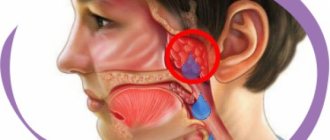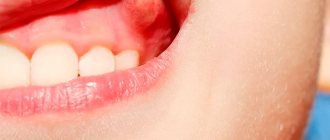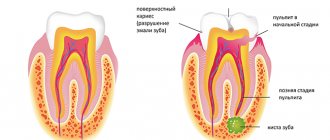Reasons for color changes in the morning
In fact, there are quite a few factors that can change the color of saliva. Among them are:
- Quite natural reasons.
- Otolaryngological diseases.
- Malfunctions of the gallbladder.
- Diseases of the digestive tract.
- Some problems in the condition of the oral cavity.
- Tumor formations.
It can be quite difficult to independently identify the cause of dark saliva in your mouth. If such a condition is in no way related to natural factors, it is necessary to seek medical help to undergo an examination and make a correct diagnosis.
Treatment
Help before diagnosis
When purulent green sputum appears, it is very important to ensure that the respiratory tract is cleared of accumulated secretions. Patients are recommended to be in a postural drainage position several times a day and do breathing exercises. You should not take antitussive drugs that aggravate the course of the disease. Green sputum occurs with serious infectious or chronic processes, so self-medication is unacceptable.
Conservative therapy
Mild forms of chronic pathology are treated on an outpatient basis. Diseases that cause green sputum often dramatically worsen the patient's condition, requiring hospitalization. If signs of respiratory failure occur, oxygen support is provided. Etiopathogenetic therapy includes the following groups of drugs:
- Antibiotics
. Prescribed to destroy pathogenic microorganisms that cause the formation of purulent green sputum. Antimicrobial agents are selected taking into account the results of bacterial culture. For the treatment of tuberculosis, special antibiotics are used in combinations of 3-4 items. - Mucolytics
. They dilute sputum, due to which it is easily removed when coughing and does not stagnate in the bronchial tree. To enhance the effect, secretomotor agents are added that stimulate mucociliary clearance. - Bronchodilators
. Effective for chronic diseases accompanied by difficulty breathing. The drugs expand the lumen of the bronchi, so it becomes easier for a person to breathe, and phlegm is released freely during a coughing attack.
If standard measures are ineffective, they resort to bronchoalveolar lavage and aspiration of purulent secretions. When performing therapeutic bronchoscopy, intrabronchial administration of antibacterial drugs is possible. Among the physiotherapeutic methods, vibration chest massage, medicinal electrophoresis, and inhalations are actively recommended.
Why does drool turn dark due to natural factors?
A change in the color of saliva towards brown can be explained quite simply - by the lack of proper oral hygiene in the evening. If you eat food with coloring properties in the evening, its particles may remain in the interdental spaces. Overnight, saliva will dissolve them, and in the morning its color will be completely unusual.
Sometimes food fragments get stuck in dentures, dental appliances (plates or braces), cavities, etc.
Most often, saliva changes color under the influence of chocolate and sweets, but rye bread and other food products can also be the culprit for such changes.
Diseases of the ENT organs
Most often, diseases of the ENT organs make themselves felt throughout the day, causing quite obvious disturbances in well-being. But a sluggish inflammatory process and some infections can make themselves felt with mild symptoms. In particular, with chronic bronchitis, COPD and tuberculosis, the patient may cough at night. If during the day such a symptom goes unnoticed and the secreted sputum is spat out, then at night it enters the oral cavity, causing the saliva to thicken and change its color to dark yellow, brown or greenish tones.
And with some ailments, even blood may well get into the saliva (this situation can develop even with a normal ARVI, when a strong cough leads to traumatization of the microvessels in the mucous membranes of the larynx). If you do not spit out the liquid immediately (which is most often not possible at night), the color of the saliva will be brown in the morning.
The most typical signs of ENT diseases that can change the color of saliva are coughing of varying degrees of intensity. The patient may also be bothered by general malaise, increased sweating and other health problems, depending on the type of illness.
Gallbladder disorders
Sometimes dark mucus, which you have to spit out in the morning, is a symptom of gallbladder disease, for example, cholelithiasis or biliary dyskinesia.
In particular, if a patient has stagnation of bile or excessive production of such a substance, it can rise into the esophagus and be thrown into the oral cavity. This liquid has a specific brownish color and, naturally, stains saliva.
With pathologies of the gallbladder, saliva acquires an unpleasant bitter taste; in addition, the patient may be bothered by other health problems:
- Pain and/or heaviness in the right hypochondrium.
- Appetite disorders.
- Nausea.
- Problems with stool - either constipation or diarrhea.
Diagnosis and treatment of gallbladder diseases is most often carried out by a gastroenterologist. But if the above-described complaints are present, the patient is recommended to first go to see a therapist.
Pathology of the gastrointestinal tract
There are quite a few diseases of the digestive tract that can change the color of saliva to a darker one. The mechanism for changing color may be as follows:
- Brownish saliva occurs in patients with gastritis, GERD and pancreatitis. If digestive juice is synthesized in excessive amounts, it can enter the esophagus along with particles of undigested food, and sometimes bile. Also, reflux occurs when the tone of the esophageal sphincter is insufficient (with GERD). The patient may also experience heartburn, discomfort in the mouth, and pain in the stomach and esophagus.
- Darkening of saliva can be explained by the presence of erosive lesions on the mucous membranes of the esophagus or stomach, for example, with erosive gastritis or ulcers. Bleeding from small capillaries can occur almost imperceptibly for the patient, but affect the color of his saliva, entering the mouth through the esophagus when in a horizontal position.
Usually, problems in the gastrointestinal tract are complemented by other health problems. You should not ignore unpleasant symptoms, because as the disease progresses, the consequences can be very dangerous to health.
Symptoms of pathology
What does the nasal mucosa look like?
As the disease progresses and mucus accumulates, it becomes necessary to clear the airways. When the bronchi are irritated by secreted mucous secretions, the cough reflex is triggered, and the urge to quickly exhale air appears.
When a lot of mucus appears, it is necessary to distinguish the cleansing process from the transition of an inflammatory disease to a chronic condition.
The coughing movement begins with a deep and sharp breath. Next, the laryngeal muscles contract. The bronchial muscles tense, while the abdominal muscles contract sharply. This is how the muscle fibers overcome the resistance of the closed glottis. Then there is a sudden opening of the glottis and a strong inhalation.
A coughing attack and discharge of mucus from the bronchi are not a disease, but may be a symptom of some disease.
What diseases appear in the mouth in the morning?
Some gum diseases can cause saliva to turn brownish. Most often, such symptoms are observed with gingivitis and periodontitis - an inflammatory process in such areas of the oral cavity. A small amount of blood is released from the affected gums, which accumulates in the mouth overnight and oxidizes, changing the color of the saliva. In addition, such diseases can make themselves felt through pain, discomfort when eating solid foods, and bleeding during daily brushing of teeth.
Treatment of gum diseases is carried out under the supervision of a dentist. Sometimes it is possible to cope with an unexpressed inflammatory process on your own - with the help of regular rinsing and proper oral care.
Why is black mucus produced?
The discharge of black sputum indicates the presence of pneumoconiosis. This is a group of occupational lung diseases. With prolonged inhalation of polluted air, tissue scarring develops. This is almost incurable. The course of the disease is chronic. It often happens that pathology may manifest itself after 5–10 years.
The reasons that cause the formation of black sputum are divided into two types:
- ingestion of foreign objects into the respiratory system, which can color the sputum in different colors;
- the development of various diseases, often dangerous.
Pneumoconiosis often causes black sputum to be discharged.
Sputum may be colored in the following cases:
- When drinking tea, strong coffee, certain drinks or other coloring substances.
- The lungs are filled with dust or crumbs of other minerals. Found among miners.
- Smoker's cough.
- One of the symptoms of pulmonary tuberculosis, gangrene, respiratory tumors, metastases.
- Pneumonia.
The appearance of black sputum is very dangerous, accompanied by such symptoms as weight loss, poor appetite, pale skin and the appearance of a waxy tint, the presence of blood clots and pus in the mucus, an unpleasant odor when breathing, chest pain, shortness of breath.
Tumor formations
Cancerous tumors can be localized in different parts of the human body, including the throat, esophagus and tongue. In some cases, such neoplasms become ulcers capable of releasing exudate. In such a situation, the patient’s saliva may acquire an atypical color, for example, turn brown. However, in this case, cancer makes itself known by other signs, for example, the sensation of a foreign body or visually noticeable changes in the mucous membranes.
Warning symptoms
In itself, an unreasonable change in the color of saliva to brown is already a very alarming sign that requires seeing a doctor. But if such a symptom is accompanied by obvious health problems, you should go to the clinic as soon as possible or even call an ambulance. In particular, this must be done when:
- Nausea that gets worse. Bloody vomiting may occur.
- High body temperature.
- Severe weakness, dizziness, disturbances of consciousness.
- The appearance of tarry (black) stools.
Of course, you should definitely consult a doctor as soon as possible if brown saliva is observed in a child, pregnant woman or elderly person.
Diagnostics
If black sputum appears, you should consult a specialist. The doctor will prescribe the necessary examination. Carry out complex diagnostics:
- radiography;
- CT scan;
- Magnetic resonance imaging;
- blood analysis.
The examination will help determine the condition of the internal organs located in the chest - heart, lungs, bronchi, trachea.
Such diagnostic measures make it possible to accurately determine the nature of sputum formation, identify the presence of tumor formations, metastases, enlargement and inflammation of the lymph nodes.
Sowing black sputum on a nutrient medium will show what kind of infection is present in it, and therefore in the body. This is very important for choosing the right treatment.
What to do?
If the color of saliva changes, it is best to consult a general practitioner. If necessary, he will refer the patient to other specialists. At home, without consulting a doctor, you can only cope with some of the causes of changes in the color of saliva. Of course, the easiest way to improve oral hygiene is to brush your teeth twice a day, use dental floss and mouthwash. You can also treat gingivitis at home in the early stages of development:
- Use special toothpastes with herbal ingredients, as well as similar rinses.
- Regularly rinse the mouth with antiseptic and anti-inflammatory solutions, for example, Miramistin, infusion of chamomile and calendula, etc.
- Adhere to a proper and balanced diet, do not injure inflamed gums with hard food.
If discomfort and redness do not go away within 2-3 days, you need to seek help from a dentist. In such a situation, targeted treatment may be required, including taking antibiotics and other medications.
Drug treatment
Medicines are prescribed depending on the cause that caused the development of black sputum:
- If the respiratory disease is caused by bacteria, antibacterial drugs are prescribed.
- For pulmonary tuberculosis, complex treatment is carried out, which includes special medications, vitamins, antibiotics, restoratives and anti-inflammatory drugs.
- For bronchial asthma, antihistamines, expectorants, and agents for dilation and cleansing of the bronchi are prescribed.
- Diseases of the respiratory system, which are accompanied by a severe cough with the release of black sputum, are treated with antitussive, antiallergic drugs, and medications that relieve inflammation.
- The patient is recommended to take general strengthening agents that increase the body's protective function, mineral and vitamin supplements.
- If respiratory cancer is detected, surgical treatment, chemotherapy, and radiation therapy are performed. In addition, an immunostimulant and high-calorie nutrition are prescribed.
To liquefy dark mucus, plant-based expectorants and synthetic drugs are prescribed. Herbal preparations have fewer negative reactions, but can cause allergies, especially in childhood.
If mucus is difficult to clear, mucolytic expectorants are used. You should not take antitussives that block the cough reflex and cause mucus stagnation. This leads to a bacterial infection and pneumonia developing. Taking any medications must be agreed with your doctor. At the same time, restorative treatment is carried out, aimed at eliminating other symptoms of the disease.
Types of medications prescribed for black phlegm
Medicines for cough with sputum are divided into several groups:
- medicinal products based on bromhexine;
- dosage form based on ambroxol;
- products based on acetylcysteine and carbocysteine;
- preparations based on herbal components (marshmallow, anise, plantain) for the treatment of other symptoms of the disease.
Antibiotics for the treatment of cough are prescribed only in severe cases. Cough syrups are widely used to treat cough in children. There are syrups that are analogous to tablets, with the same composition and effect.
Treatment of cough with phlegm is also carried out with the help of herbs. For medicinal collection, pine buds, onions, garlic, mint, chamomile, St. John's wort, and sage are used. Special breast preparations, which can be purchased in ready-made form in pharmacies, are effective.









